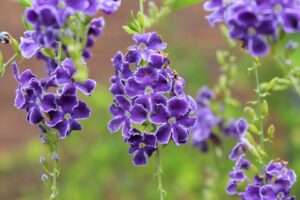Tips on How to Hedge Golden Dewdrop

Golden dewdrop or Duranta erecta thrives best in tropical to warm sub-tropical regions, this perennial is native to Tropical America and ranges from the Florida Keys through Mexico and South America. The golden dewdrop is a species of flowering shrub in the verbena family Verbenaceas, this fast-growing evergreen produces yellow, green, or variegated leaves with small purple flowers that are showy.
Why I recommend making these garden beauties a part of your landscapes is when the flower bloom season is over you will still have colors ( yellow beautiful leaves) that will continue throughout the season. The berries that the golden Duranta produces attracts hummingbird while the flowers attract butterflies, this plant specie will truly complement a wildlife garden.
I have worked on several garden projects with golden dewdrop and have seen the flavor they bring, a word of caution, however, be very careful when installing golden dewdrops because dewdrop has thrones or tiny prickles and can deliver a painful stick. Although hummingbirds are attracted to the berries or fruits that are produced these berries are poisonous to humans and pets so make sure that children and pets don’t have access to or come in contact with these plants.
How to Hedge Golden Dewdrop
Golden Durantas can be grown as a tree, shrub, or hedge, when seeking to grow the golden dewdrop as a hedge give the plant the right spacing at the time of planting. What you don’t want to do is plant them too close because closely planting them will discourage proper air circulation. When planting give them a spacing of 3-5 ft, as the plant begins to grow avoid the removal of the outward growth.
The outward growth should be allowed to make contact with each other, the upper growth, however, can be slightly pruned back to the desired height but avoid removing too much of the outward growth except if the outgrowth is growing in the wrong direction.
Continue this process every few months as you continue to monitor their growth, any branches that are broken, diseased or dead should be removed as you make your rounds of regular pruning. The key to creating a hedge is to allow the plant’s outward growth to mature as they grow toward each other. The best tool for the job while the plant is still young is a hedge shear.
Once the plant is established you can continue to use hedge shears but if the hedge is large then a gas-powered hedge trimmer will make your job much easier.
Signs of Poisoning if the Leaves or the Berries are Consumed
- Vomiting
- Intense Nausea
- Diarrhoea
- Dizziness
- Irregular heartbeat
- Drooling in the case of a dog being poisoning
- Seizures
Other Common Names of the Golden Duranta
- Golden Tears
- Skyflower
- Golden Eardrops
- Pigeon Berry
- Pidgeon Berry
- Forget-me-not-bush
- Forget-me-not-tree
- Vanilla Bush
- Brazilian Sky Flower
- Angels Whisper
- Creeping Skin Flower
Other Articles on the Golden dewdrop
- Golden Dewdrop Plant Care
- Golden Duranta Tree Pruning
- Growing Golden Duranta from Cuttings
- How to Grow Golden Duranta Seeds
The final word on how to hedge golden dewdrop
Keep your golden dewdrop well manicure is that simple, these plants once established make a good hedge but as said earlier as beautiful as golden dewdrop be very careful when placing them because the leaves and the berries are known to be poisonous to humans and pets. This tropical-sub-tropical plant is a beauty and will work wonders for you as they bring that much-needed flavor to your garden and landscapes.
About the author
Norman loves being in the garden, both at home and for his job....
he is 'Natures Little helper' being outdoors, growing his vegetables and flowers from an early age.
Now having spent over 22 years in the profession he want to give some of his knowledge to others...
his vast array of hints and tips you will find scattered over this site will help you no end growing plants in your garden.
